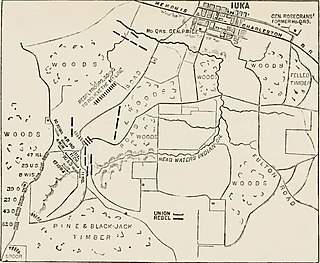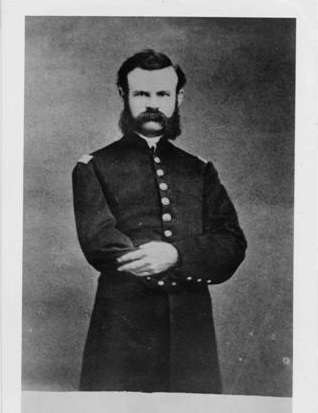Related Research Articles

The Battle of Chickamauga, fought on September 18–20, 1863, between the United States Army and Confederate forces in the American Civil War, marked the end of a U.S. Army offensive, the Chickamauga Campaign, in southeastern Tennessee and northwestern Georgia. It was the first major battle of the war fought in Georgia, the most significant US defeat in the Western Theater, and involved the second-highest number of casualties after the Battle of Gettysburg.

The Battle of Stones River, also known as the Second Battle of Murfreesboro, was fought from December 31, 1862, to January 2, 1863, in Middle Tennessee, as the culmination of the Stones River Campaign in the Western Theater of the American Civil War. Of the major battles of the war, Stones River had the highest percentage of casualties on both sides. The battle ended in Union victory after the Confederate army's withdrawal on January 3, largely due to a series of tactical miscalculations by Confederate Gen. Braxton Bragg, but the victory was costly for the Union army. Nevertheless, it was an important victory for the Union because it provided a much-needed boost in morale after the Union's recent defeat at Fredericksburg and also reinforced President Abraham Lincoln's foundation for issuing the Emancipation Proclamation, which ultimately discouraged European powers from intervening on the Confederacy's behalf.

William Starke Rosecrans was an American inventor, coal-oil company executive, diplomat, politician, and U.S. Army officer. He gained fame for his role as a Union general during the American Civil War. He was the victor at prominent Western Theater battles, but his military career was effectively ended following his disastrous defeat at the Battle of Chickamauga in 1863.

The Battle of Missionary Ridge, also known as the Battle of Chattanooga, was fought on November 25, 1863, as part of the Chattanooga campaign of the American Civil War. Following the Union victory in the Battle of Lookout Mountain on November 24, Union forces in the Military Division of the Mississippi under Maj. Gen. Ulysses S. Grant assaulted Missionary Ridge and defeated the Confederate Army of Tennessee, commanded by Gen. Braxton Bragg, forcing it to retreat to Georgia.

The Second Battle of Corinth was fought October 3–4, 1862, in Corinth, Mississippi. For the second time in the Iuka–Corinth Campaign, Union Maj. Gen. William Rosecrans defeated a Confederate army, this time one under Maj. Gen. Earl Van Dorn.

The Battle of Iuka was fought on September 19, 1862, in Iuka, Mississippi, during the American Civil War. In the opening battle of the Iuka-Corinth Campaign, Union Maj. Gen. William Rosecrans stopped the advance of the Confederate Army of the West commanded by Maj. Gen. Sterling Price.

John McArthur was a Union general during the American Civil War. McArthur became one of the most capable Federal commanders in the Western Theater.
The following Union Army units and commanders fought in the Battle of Nashville of the American Civil War. Order of battle compiled from the army organization during the battle. The Union force was a conglomerate of units from several different departments provisionally attached to George H. Thomas’ Department of the Cumberland. The IV Corps and the District of Etowah were permanently attached to the Department of the Cumberland while the Cavalry Corps had been attached to the Army of the Cumberland until October 1864 when it was transferred to the Military Division of the Mississippi. The XXIII Corps was detached from the Department of the Ohio and Smith’s Corps was detached from the Department of the Tennessee. Other brigades and regiments from the Army of the Tennessee which were unable to rejoin their respective commands were organized into the Provisional Division and attached to the District of the Etowah.
The following Union Army units and commanders fought in the Battle of Antietam of the American Civil War. The Confederate order of battle is listed separately. Order of battle compiled from the army organization during the Maryland Campaign, the casualty returns and the reports.
The following Union Army units and commanders fought in the Battle of Stones River of the American Civil War. The Confederate order of battle is listed separately. Order of battle compiled from the army organization during the campaign, the casualty returns and the reports.
The following Union Army units and commanders fought in the Battle of Chickamauga of the American Civil War. The Confederate order of battle is listed separately. Order of battle compiled from the army organization during the campaign.
The following units and commanders of the Union Army fought at the Siege of Corinth of the American Civil War. The Union Army had approximately 150,000 present for duty. The Confederate order of battle is shown separately. Order of battle compiled from the army organization during the siege.
The following units and commanders fought in the Chattanooga–Ringgold campaign of the American Civil War on the Confederate side. The Union order of battle is shown separately. Order of battle compiled from the army organization on November 20, 1863 and the reports.
The following Union Army units and commanders fought in the Battle of Westport of the American Civil War. The Confederate order of battle is listed separately.
The following Confederate Army units and commanders fought in the Second Battle of Corinth of the American Civil War on October 3 and 4, 1862, in Corinth, Mississippi. Order of battle compiled from the army organization during the battle and reports. The Union order of battle is listed separately.
The following Union Army units and commanders fought in the Battle of Fort Stevens of the American Civil War on July 11–12, 1864. The Confederate order of battle is listed separately.

The following Union Army units and commanders fought in the Knoxville Campaign and subsequent East Tennessee operations during the American Civil War from November 4 to December 23, 1863 under the command of Maj. Gen. Ambrose E. Burnside. Engagements fought during this time included the battles of Campbell's Station and Fort Sanders and the siege of Knoxville. Order of battle compiled from the army organization during the campaign and return of casualties. The Confederate order of battle is shown separately.
The following units and commanders fought in the Chattanooga–Ringgold campaign of the American Civil War on the Union side. The Confederate order of battle is shown separately. Order of battle compiled from the army organization during the campaign, the casualty returns and the reports.
The following units and commanders of the Confederate Army fought at the Siege of Corinth of the American Civil War. The Union order of battle is shown separately. Order of battle compiled from the Official Records of the American Civil War as they appeared on June 30, 1862.

Battery F, 2nd Illinois Light Artillery Regiment was an artillery battery from Illinois that served in the Union Army during the American Civil War. The battery was organized in December 1861 at Cape Girardeau, Missouri. The unit fought at Shiloh, First Corinth, and Second Corinth in 1862 and at Vicksburg and Jackson in 1863. The battery served in the Atlanta campaign and at Nashville in 1864. It was mustered out of federal service in July 1865. The battery's first commander was John Wesley Powell who later led an exploration of the Grand Canyon.
References
- War of the Rebellion: A Compilation of the Official Records of the Union and Confederate Armies Volume XVII Part I. Washington, DC: Government Printing Office. 1886. pp. 173–176, 336. Retrieved January 22, 2021.
- Eicher, John H., and David J. Eicher. Civil War High Commands. Stanford, CA: Stanford University Press, 2001. ISBN 0-8047-3641-3.
- Cozzens, Peter (1997). The Darkest Days of the War: The Battles of Iuka and Corinth. Chapel Hill, N.C.: University of North Carolina Press. ISBN 0-8078-5783-1.